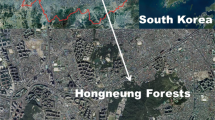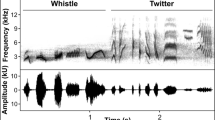Abstract
Producing calls with increased minimum carrier frequency is well documented in sound communicating species confronted with noise pollution, possibly helping them to avoid acoustic masking of low-frequency signals. However, the lack of studies on invertebrates limits our understanding of the potentially adverse effects of anthropogenic noise on natural populations. While males of the grasshopper Chorthippus biguttulus are known to produce courtship signals with elevated low-frequency local maxima (LFLM) in roadside populations, previous studies provided no insight into morphological traits underlying LFLM shifts. Although developmental plasticity was identified as one main factor accounting for elevated LFLM, an additional role for a more hard-wired trait architecture was proposed, possibly as a result of adaptation to traffic noise. Our current study therefore aims to assess (1) whether the position of LFLM is related to male body size, (2) whether body size is correlated with motorway age, and (3) whether the position of LFLM is correlated with motorway age in C. biguttulus males from roadside populations. In addition to substantial variation in LFLM among C. biguttulus males, we found that larger males produced signals with lower LFLM, suggesting a potential role in female choice as a predictor of male quality. While we found no significant correlation between LFLM and motorway age, C. biguttulus males were larger near older motorway sections. This positive correlation may be due to several reasons, including: (1) higher nutrient concentration and availability in plant tissues due to eutrophication of roadside habitats; (2) temporal succession of male size phenotypes during colonization processes; and/or (3) selection for larger body size in roadside populations. Our results highlight the multifaceted and often complex nature of the relationships between morphology, signal traits and anthropogenic pressures on sound communication in invertebrates.





Similar content being viewed by others
References
Angold PG (1997) The impact of a road upon adjacent heathland vegetation: effects on plant species composition. J Appl Ecol 34:409. https://doi.org/10.2307/2404886
Bartoń K (2019) Multi-model inference version 1.43.6. https://cran.r-project.org/package=MuMIn. Accessed 4 Dec 2019
Bates D, Mächler M, Bolker B, Walker S (2015) Fitting linear mixed-effects models using lme4. J Stat Softw 67:1–48. https://doi.org/10.18637/jss.v067.i01
Bennet-Clark HC (1998) Size and scale effects as constraints in insect sound communication. Philos Trans R Soc B Biol Sci 353:407–419. https://doi.org/10.1098/rstb.1998.0219
Bent AM, Ings TC, Mowles SL (2018) Anthropogenic noise disrupts mate searching in Gryllus bimaculatus. Behav Ecol 29:1271–1277. https://doi.org/10.1093/beheco/ary126
Brown WD, Wideman J, Andrade MCB et al (1996) Female choice for an indicator of male size in the song of the Black-Horned Tree Cricket, Oecanthus nigricornis (Orthoptera: Gryllidae: Oecanthinae). Evolution 50:2400. https://doi.org/10.2307/2410708
Bunkley JP, McClure CJW, Kawahara AY et al (2017) Anthropogenic noise changes arthropod abundances. Ecol Evol 7:2977–2985. https://doi.org/10.1002/ece3.2698
Costello RA, Symes LB (2014) Effects of anthropogenic noise on male signalling behaviour and female phonotaxis in Oecanthus tree crickets. Anim Behav 95:15–22. https://doi.org/10.1016/j.anbehav.2014.05.009
Dowling JL, Luther DA, Marra PP (2012) Comparative effects of urban development and anthropogenic noise on bird songs. Behav Ecol 23:201–209. https://doi.org/10.1093/beheco/arr176
Einhäupl A, Stange N, Hennig RM, Ronacher B (2011) Attractiveness of grasshopper songs correlates with their robustness against noise. Behav Ecol 22:791–799. https://doi.org/10.1093/beheco/arr064
Ferguson GL (2018) How developmental and behavioural plasticity in the fall field cricket is influenced by the acoustic social environment and anthropogenic noise. Carleton University, Ottawa
Finck J, Kuntze J, Ronacher B (2016) Chemical cues from females trigger male courtship behaviour in grasshoppers. J Comp Physiol A 202:337–345. https://doi.org/10.1007/s00359-016-1081-4
Francis CD, Ortega CP, Cruz A (2009) Noise pollution changes avian communities and species interactions. Curr Biol 19:1415–1419. https://doi.org/10.1016/j.cub.2009.06.052
Francis CD, Ortega CP, Cruz A (2011) Noise pollution filters bird communities based on vocal frequency. PLoS ONE 6:e27052. https://doi.org/10.1371/journal.pone.0027052
Franzke A, Reinhold K (2011) Stressing food plants by altering water availability affects grasshopper performance. Ecosphere 2:1–13. https://doi.org/10.1890/ES11-00095.1
García-Navas V, Noguerales V, Cordero PJ, Ortego J (2017) Ecological drivers of body size evolution and sexual size dimorphism in short-horned grasshoppers (Orthoptera: Acrididae). J Evol Biol 30:1592–1608. https://doi.org/10.1111/jeb.13131
Gerhardt HC (1991) Female mate choice in treefrogs: static and dynamic acoustic criteria. Anim Behav 42:615–635. https://doi.org/10.1016/S0003-3472(05)80245-3
Gottsberger B, Mayer F (2007) Behavioral sterility of hybrid males in acoustically communicating grasshoppers (Acrididae, Gomphocerinae). J Comp Physiol A 193:703–714. https://doi.org/10.1007/s00359-007-0225-y
Gross K, Pasinelli G, Kunc HP (2010) Behavioral plasticity allows short-term adjustment to a novel environment. Am Nat 176:456–464. https://doi.org/10.1086/655428
Gurule-Small GA, Tinghitella RM (2018) Developmental experience with anthropogenic noise hinders adult mate location in an acoustically signalling invertebrate. Biol Lett 14:20170714. https://doi.org/10.1098/rsbl.2017.0714
Joern A, Klucas G (1993) Intra- and interspecific competition in adults of two abundant grasshoppers (Orthoptera: Acrididae) from a sandhills grassland. Environ Entomol 22:352–361. https://doi.org/10.1093/ee/22.2.352
Kasumovic MM, Hall MD, Try H, Brooks RC (2011) The importance of listening: juvenile allocation shifts in response to acoustic cues of the social environment. J Evol Biol 24:1325–1334. https://doi.org/10.1111/j.1420-9101.2011.02267.x
Klappert K, Reinhold K (2003) Acoustic preference functions and sexual selection on the male calling song in the grasshopper Chorthippus biguttulus. Anim Behav 65:225–233. https://doi.org/10.1006/anbe.2002.2034
Kral K (2008) Similarities and differences in the peering-jump behavior of three grasshopper species (Orthoptera: Caelifera). Insect Sci 15:369–374. https://doi.org/10.1111/j.1744-7917.2008.00223.x
Kuznetsova A, Brockhoff PB, Christensen RHB (2017) lmerTest package: tests in linear mixed effects models. J Stat Softw 82:1–26. https://doi.org/10.18637/jss.v082.i13
Lampe U, Schmoll T, Franzke A, Reinhold K (2012) Staying tuned: grasshoppers from noisy roadside habitats produce courtship signals with elevated frequency components. Funct Ecol 26:1348–1354. https://doi.org/10.1111/1365-2435.12000
Lampe U, Reinhold K, Schmoll T (2014) How grasshoppers respond to road noise: developmental plasticity and population differentiation in acoustic signalling. Funct Ecol 28:660–668. https://doi.org/10.1111/1365-2435.12215
Lehmann GUC, Lehmann AW (2008) Bushcricket song as a clue for spermatophore size? Behav Ecol Sociobiol 62:569–578. https://doi.org/10.1007/s00265-007-0481-4
Loganathan P, Vigneswaran S, Kandasamy J (2013) Road-deposited sediment pollutants: a critical review of their characteristics, source apportionment, and management. Crit Rev Environ Sci Technol 43:1315–1348. https://doi.org/10.1080/10643389.2011.644222
McClure CJW, Ware HE, Carlisle J et al (2013) An experimental investigation into the effects of traffic noise on distributions of birds: avoiding the phantom road. Proc R Soc B Biol Sci 280:20132290–20132290. https://doi.org/10.1098/rspb.2013.2290
Montealegre-Z F (2009) Scale effects and constraints for sound production in katydids (Orthoptera: Tettigoniidae): correlated evolution between morphology and signal parameters. J Evol Biol 22:355–366. https://doi.org/10.1111/j.1420-9101.2008.01652.x
Montealegre-Z F, Ogden J, Jonsson T, Soulsbury CD (2017) Morphological determinants of signal carrier frequency in katydids (Orthoptera): a comparative analysis using biophysical evidence of wing vibration. J Evol Biol 30:2068–2078. https://doi.org/10.1111/jeb.13179
Morley EL, Jones G, Radford AN (2013) The importance of invertebrates when considering the impacts of anthropogenic noise. Proc R Soc B Biol Sci 281:20132683–20132683. https://doi.org/10.1098/rspb.2013.2683
Nakagawa S, Johnson PCD, Schielzeth H (2017) The coefficient of determination R2 and intra-class correlation coefficient from generalized linear mixed-effects models revisited and expanded. J R Soc Interface 14:20170213. https://doi.org/10.1098/rsif.2017.0213
Nemeth E, Brumm H (2010) Birds and anthropogenic noise: are urban songs adaptive? Am Nat 176:465–475. https://doi.org/10.1086/656275
Parris KM, Velik-Lord M, North JMA (2009) Frogs call at a higher pitch in traffic noise. Ecol Soc 14:25. https://doi.org/10.2307/26268025
Port GR, Thompson JR (1980) Outbreaks of insect herbivores on plants along motorways in the United Kingdom. J Appl Ecol 17:649–656
R Core Team (2018) R: a language and environment for statistical computing. https://www.r-project.org/
Robinson DJ, Hall MJ (2002) Sound signalling in Orthoptera. 2806:151–278. https://doi.org/10.1016/S0065-2806(02)29003-7
Rodríguez-Flores M, Rodríguez-Castellón E (1982) Lead and cadmium levels in soil and plants near highways and their correlation with traffic density. Environ Pollut Ser B Chem Phys 4:281–290. https://doi.org/10.1016/0143-148X(82)90014-3
Ronacher B, Krahe R, Hennig RM (2000) Effects of signal duration on the recognition of masked communication signals by the grasshopper Chorthippus biguttulus. J Comp Physiol A 186:1065–1072. https://doi.org/10.1007/s003590000153
Safi K, Heinzle J, Reinhold K (2006) Species recognition influences female mate preferences in the common European grasshopper (Chorthippus biguttulus Linnaeus, 1758). Ethology 112:1225–1230. https://doi.org/10.1111/j.1439-0310.2006.01282.x
Sandberg U, Kropp W, Larsson K (2003) The multi-coincidence peak around 1 kHz in tyre/road noise spectra. Euronoise Naples 498:1–8
Schmidt AKD, Balakrishnan R (2015) Ecology of acoustic signalling and the problem of masking interference in insects. J Comp Physiol A 201:133–142. https://doi.org/10.1007/s00359-014-0955-6
Schneider CA, Rasband WS, Eliceiri KW (2012) NIH Image to ImageJ: 25 years of image analysis. Nat Methods. https://doi.org/10.1038/nmeth.2089
Shannon G, McKenna MF, Angeloni LM et al (2016) A synthesis of two decades of research documenting the effects of noise on wildlife. Biol Rev 91:982–1005. https://doi.org/10.1111/brv.12207
Shieh B-S, Liang S-H, Chen C-C et al (2012) Acoustic adaptations to anthropogenic noise in the cicada Cryptotympana takasagona Kato (Hemiptera: Cicadidae). Acta Ethol 15:33–38. https://doi.org/10.1007/s10211-011-0105-x
Siemers BM, Schaub A (2011) Hunting at the highway: traffic noise reduces foraging efficiency in acoustic predators. Proc R Soc B Biol Sci 278:1646–1652. https://doi.org/10.1098/rspb.2010.2262
Slabbekoorn H, Peet M (2003) Birds sing at a higher pitch in urban noise. Nature 424:267–267. https://doi.org/10.1038/424267a
Stange N, Ronacher B (2012a) Song characteristics and morphological traits in four populations of the grasshopper Chorthippus biguttulus L. J Comp Physiol A 198:763–775. https://doi.org/10.1007/s00359-012-0746-x
Stange N, Ronacher B (2012b) Grasshopper calling songs convey information about condition and health of males. J Comp Physiol A 198:309–318. https://doi.org/10.1007/s00359-012-0709-2
Stoffel MA, Nakagawa S, Schielzeth H (2017) rptR: repeatability estimation and variance decomposition by generalized linear mixed-effects models. Methods Ecol Evol 8:1639–1644. https://doi.org/10.1111/2041-210X.12797
von Helversen D, von Helversen O (1997) Recognition of sex in the acoustic communication of the grasshopper Chorthippus biguttulus (Orthoptera, Acrididae). J Comp Physiol A 180:373–386. https://doi.org/10.1007/s003590050056
von Helversen D, Balakrishnan R, von Helversen O (2004) Acoustic communication in a duetting grasshopper: receiver response variability, male strategies and signal design. Anim Behav 68:131–144. https://doi.org/10.1016/j.anbehav.2003.10.020
Whitman DW (2008) The significance of body size in the Orthoptera: a review. J Orthoptera Res 17:117–134
Whitman DW, Vincent S (2008) Large size as an antipredator defense in an insect. J Orthoptera Res 17:353–371. https://doi.org/10.1665/1082-6467-17.2.353
Yager DD (1999) Structure, development, and evolution of insect auditory systems. Microsc Res Tech 47:380–400
Acknowledgements
We are grateful to Holger Schielzeth for sampling grasshoppers at two locations. Furthermore, we would like to thank Hansjoerg Kunc and an anonymous reviewer for improving the quality of the paper with their constructive comments and suggestions. This work was funded by a Forschungs- und Innovationsförderung (FIF) Grant of Bielefeld University’s Faculty of Biology to T.S., a Grant of Westfälisch-Lippische Universitätsgesellschaft to K.P. and by an Erasmus + Traineeship grant of the University of Zagreb for the academic year 2015/16 to F.R.
Author information
Authors and Affiliations
Contributions
F.R. analysed the courtship songs and lead the writing of the manuscript. K.P. recorded the courtship songs and created the protocol for taking morphometric measurements. M.I. performed the morphometric measurements. K.R. proposed the project, lead the field work and supervised the bioacoustic analysis. T.S. performed the statistical analysis, contributed to writing and supervised the morphometric analysis. All authors commented on the manuscript draft and gave the final approval for publication.
Corresponding author
Ethics declarations
Conflict of interest
The authors declare that they have no conflict of interest.
Rights and permissions
About this article
Cite this article
Rebrina, F., Petróczki, K., Inhofer, M. et al. Motorway age is linked to larger body size, but not song carrier frequency, in male grasshoppers from roadside populations. Evol Ecol 34, 945–961 (2020). https://doi.org/10.1007/s10682-020-10077-7
Received:
Revised:
Accepted:
Published:
Issue Date:
DOI: https://doi.org/10.1007/s10682-020-10077-7




